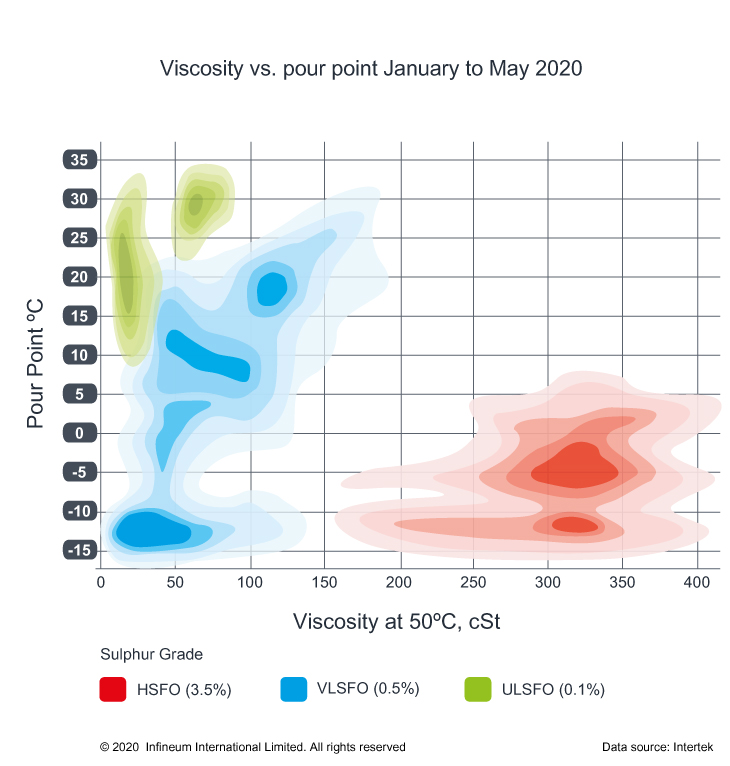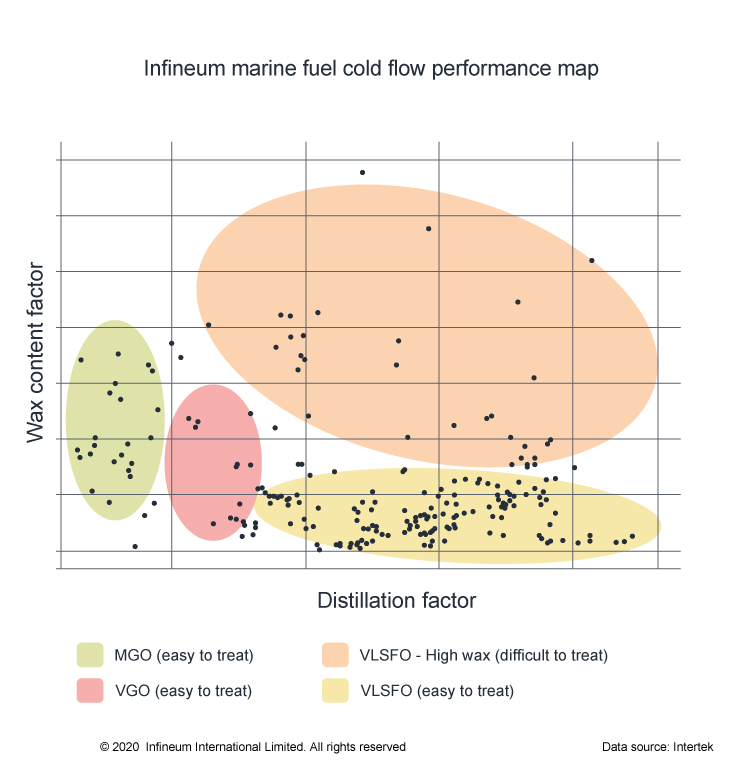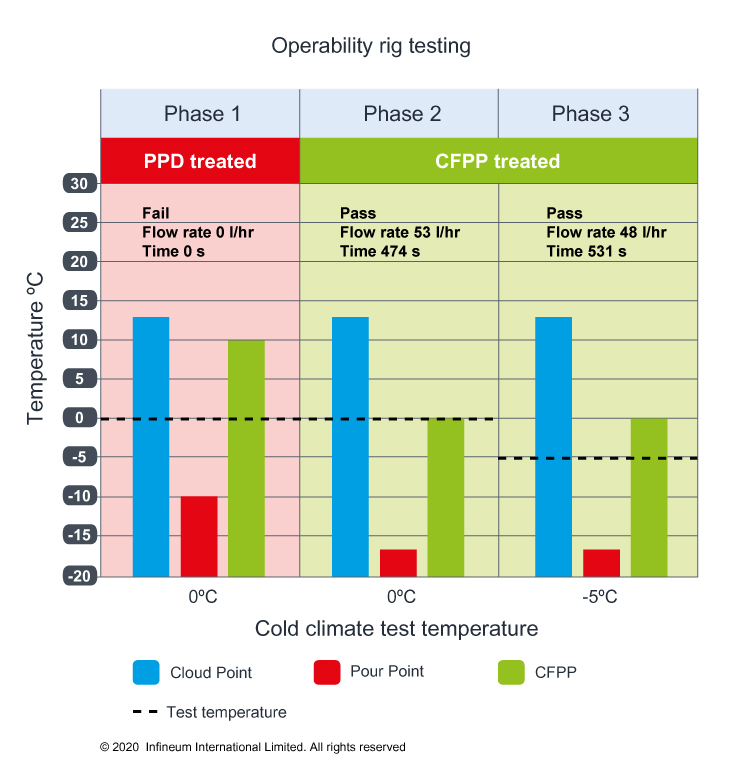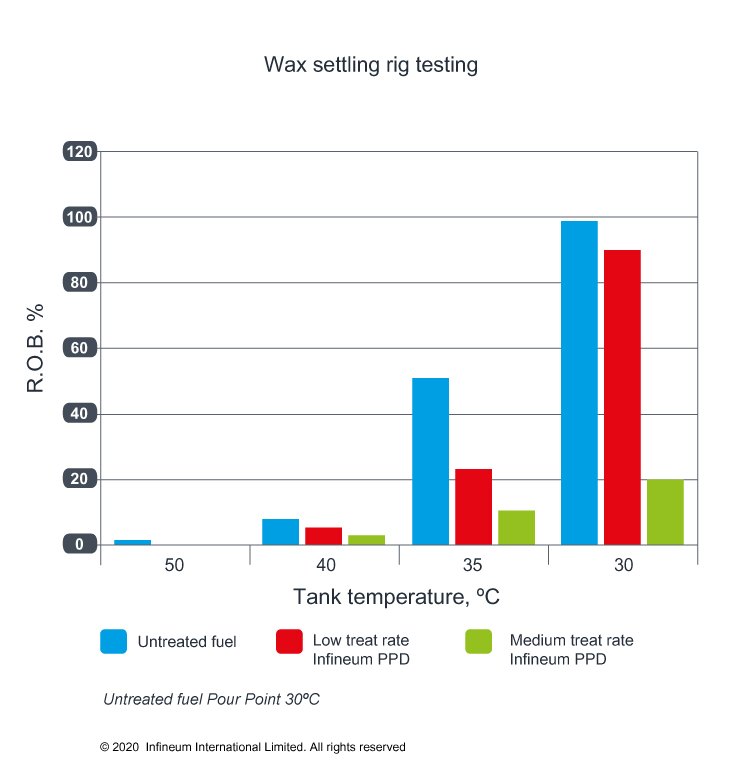Fuels
Driving hydrogen forward
21 January 2025
04 August 2020
Marine Venture Team reveals impact of IMO sulphur reductions on cold flow properties

To meet the latest IMO marine fuel sulphur regulations, refiners have been producing very low sulphur fuel oil grades, which are quite different from their heavy fuel oil equivalents. Rob Ashton, Infineum Marine Fuel Additive Business Development Manager, and Steve Benwell, Global Fuels Key Accounts Manager, highlight the ways fuel additives are being used to overcome the cold flow challenges that can arise when using these higher wax content fuels.
In 2005, International Maritime Organization (IMO) first introduced regulations to reduce the emissions of sulphur oxides from ships, under Annex VI of the International Convention for the Prevention of Pollution from Ships (MARPOL). Since this time, sulphur oxide limits have been progressively tightened and extended with, for example, the introduction of Emission Control Areas (ECAs), where a 0.1% sulphur cap applies and the IMO 2020 0.5% global cap - the latter entering into force on January 1 2020.
Foreseeing the impact that these sulphur reduction programmes would be likely to have on future marine fuels, Infineum formed a Marine Venture Team. Back in 2016, when the IMO 2020 sulphur reduction regulation was confirmed, this Team embarked on a program to anticipate the properties that the new IMO 2020 compliant fuels might have.
In the lead up to IMO 2020, one key issue for the additive industry was test fuel availability. Fuel suppliers were understandably reluctant to share plans about their IMO 2020 solutions. Hence, the specifics of how the new fuels might look, their physical and chemical characteristics and how they would behave in commerce were unknown.
In advance of IMO 2020 fuels being readily available, the Marine Venture Team started work so that additive solutions would be ready in time to meet industry needs.
Since late 2019, a useful source of information on commercial fuels has been the testing service companies. The specification test data they produce on market fuels has enabled the identification of key performance and characteristics differences between new low sulphur and old high sulphur fuels e.g. stability, compatibility, cold flow and viscosity, which in most cases has verified predictions.
It was apparent, from a refiners perspective, that the most cost effective way to reduce sulphur levels in heavy marine fuels would be to blend a low sulphur distillate cutter stock (which is relatively easy to desulphurise) with heavy, higher sulphur residual components. This approach to meeting the new sulphur specification reduced the need for investment in CAPEX intensive residual conversion and/or desulphurisation units.
One key area of focus for the Team has been stability and compatibility control, which was expected to be challenging through this fuel blending approach.
Click here to read a previous article on these issues and the solutions that additives can provide.
In addition, the introduction of more paraffinic (waxier) low sulphur componentry to marine fuels means wax and viscosity related issues were also expected to become more prevalent. The Marine Venture Team has already built up a good understanding of these new very low sulphur marine fuels in terms of cold flow properties and the approaches that might be used to manage their higher wax content.
Data collected between January and May 2020 indicates that the very low sulphur fuel oil (VLSFO) grades produced have lower viscosity and higher pour point than their heavy fuel oil (HFO) equivalents.
 2020 data indicates very low sulphur fuels are different from conventional HFO
2020 data indicates very low sulphur fuels are different from conventional HFO
Higher pour points invariably mean that the fuels contain more wax, which on its own can be managed through heating the fuel. However, when the fuels also have lower viscosities, applying extra heat to manage the wax can make it challenging to meet the optimum fuel viscosity at point of injection (ca. 10 cSt). In addition, the application of extra heat can also exacerbate stability issues leading to asphaltene agglomeration. The use of effective cold flow additives is an alternative approach that can reduce the need to apply excess heating.
Infineum has a long history of providing innovative cold flow additive solutions to the diesel fuel market and has applied its tried and trusted methodologies to the development of effective solutions for new marine fuels. The two-stage development process involved both fuel mapping and rig development techniques.
Stage 1: fuel mapping
Fuel mapping involves building a fuel-type ‘library’ in which a full suite of analytical characterisation and performance tests are carried out on each individual fuel. The data is then analysed to determine attribute/performance areas using complex algorithms of key test data to assist in the development of improved additive solutions to treat specific mapping areas.
Throughout 2019, Infineum worked with its customers to develop specific solutions for their IMO 2020 needs. But, as fuel availability eased during the third quarter of 2019, it was possible to build a sizeable database, which enabled the construction of a cold flow performance map.

The map revealed that some of the new VLSFO grades are particularly severe with regard to cold flow treatment and some have proved impossible to treat. However, additives and fuel mapping can still play a role here by moving some ‘impossible to treat fuels’ into a responsive area through a combination of component blending and additive treatment.
In addition to this in-house mapping work, collaboration with service providers has provided further insight into VLSFO cold flow properties. Recently some of these organisations have reported that pour point may no longer provide sufficient protection from waxing issues in VLSFOs. Waxy gels and/or solids may be present at temperatures significantly above the VLSFO pour point (up to 30oC). Consequently, it is probable that operability issues may occur at temperatures well above the pour point of the fuel*.
Tests carried out by Infineum show that additives can be used to not only depress pour point but also improve operability, thus providing extra insurance for safe VLSFO operation. This capability has been demonstrated in stage two of the development process.
Stage 2: rig development
This involves the development of equipment to mimic real world hardware scenarios that go beyond standard performance/specification tests and working with industry stakeholders to verify engineering assumptions on engine operability. These rigs are then used to confirm additive performance windows prior to field trial and market deployment.
To further aid the fundamental understanding of wax in these new marine fuels, Infineum has developed two rigs.
The operability rig aims to replicate the potential blockage of strainers and filters in the fuel delivery system by wax in marine distillate fuels. The rig consists of a fuel reservoir, fuel pump and filter assembly equipped with temperature and flow rate sensors all housed in a controllable climate chamber (note the flow rate and filter size can be adjusted to replicate different engine modes). The rig was initially calibrated with high cloud point automotive diesel fuels, which closely mimic low sulphur marine DMA grades.
In the first phase of the test, fuels were treated with pour point depressant (PPD) to at least the test temperature of 0°C and sometimes significantly below it. The test was run and on all occasions the test did not run to completion thus recording a fail. These rig trial results demonstrate that pour point depressants do not protect the fuel delivery system.
In phase two, the experiment was repeated under the same conditions with the test fuels treated with cold filter plugging point (CFPP) improver additives to the test temperature of 0°C. All tests ran to completion whilst recording good flow rates demonstrating that CFPP gives improved protection over pour point.
In the third phase of testing, the phase two CFPP improver treated fuels were re-tested at a lower test temperature of -5°C (i.e. below the CFPP of the treated fuels). Once again, all tests passed albeit with slightly lower flow rates.

These tests have demonstrated the extra protection offered by CFPP improvers over PPD additives. CFPP improver additives can help to avoid blockages in fuel strainers and filters and help to protect against operability issues. Subsequent testing in customer distillate fuels have followed the same trends.
Given that many VLSFOs have high pour points (i.e. are very waxy) and have low viscosities, a second wax settling rig was developed to investigate the effect of PPDs in reducing wax accumulation in VLSFO tanks.
This rig sits in a programmable climate chamber and consists of a glass-fronted fuel tank fitted with baffles and a heating coil in the bottom of the tank. The test fuel is introduced to the tank and cooled (either controlled or crash cooled) to the required test temperature and left to soak for an extended time period of up to 24 hours. The fuel is then heated for an hour, after which it is pumped out and the remain-on-board (RoB) waxy residue is quantified. Infineum pour point depressants have demonstrated the ability to change the morphology of the wax to a softer consistency (confirmed by cold finger test analysis) and positively influence the dynamic viscosity of the fuel by reducing the gel network strength, which means they are very effective at reducing RoB.

Prior to the introduction of the IMO low sulphur regulations, marine fuel additive use had been limited to a few niche applications, for example, tank cleaning and combustion improvement. Consequently, fuel additives have not been considered as a trusted, integral part of a marine fuel blender’s toolkit. However, as the properties of marine fuels change, the use of additives to overcome cold flow challenges that can be associated with their use is likely to increase.
Through extensive testing, Infineum cold flow additive technologies have demonstrated the ability to maintain uninterrupted fuel flow and reduce remain-on-board at lower temperatures in low viscosity VLSFOs.
The benefits these additive technologies deliver can help to remove viscosity concerns at point of fuel injection and eliminate unnecessary thermal stress, which could lead to asphaltene agglomeration and subsequent storage tank sludge accumulation and purifier operational issues.
* This had already been identified as an issue for low sulphur distillate fuels and as a consequence the 2017 version of ISO 8217 included a requirement to report Cloud Point (CP) and Cold Filter Plugging Point (CFPP) values to allow ship operators to assess fuel usability for their applications.
Sign up to receive monthly updates via email